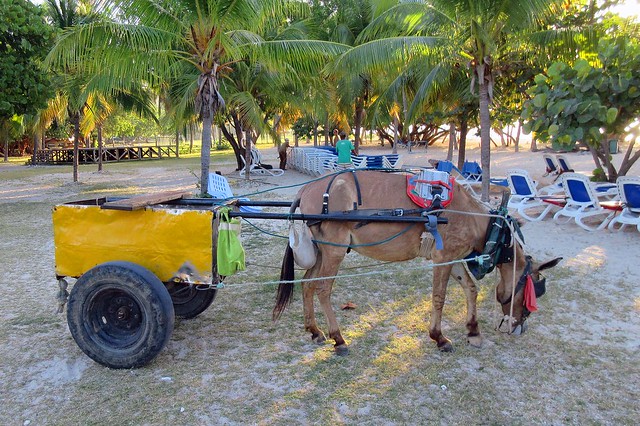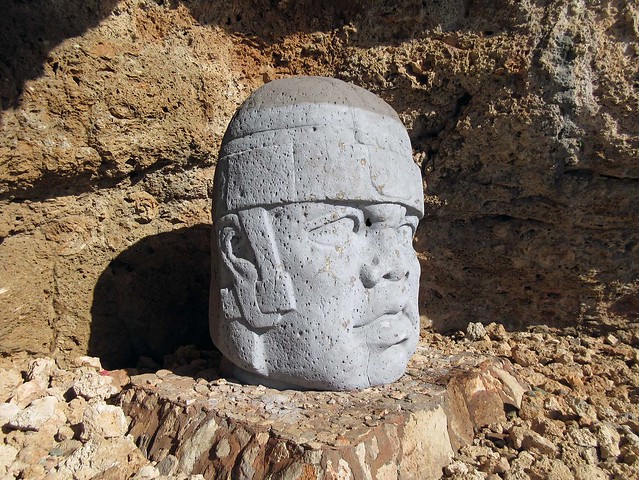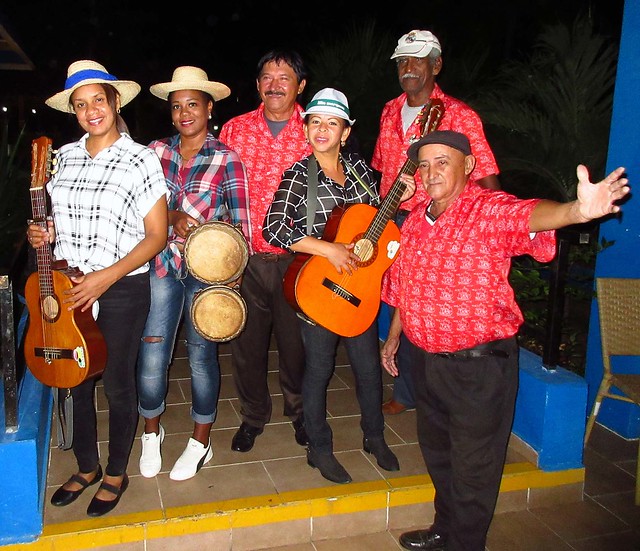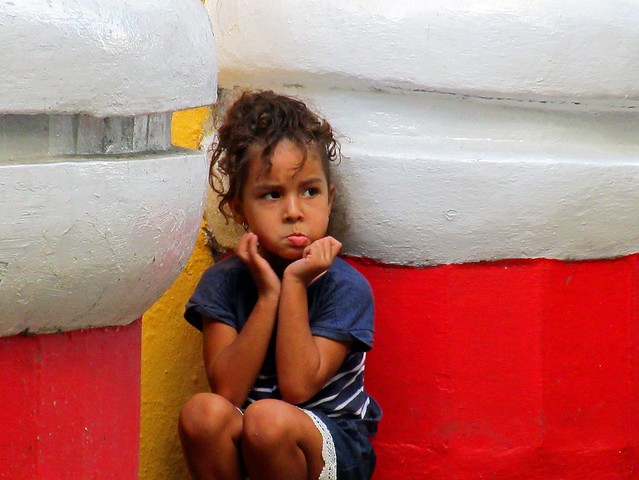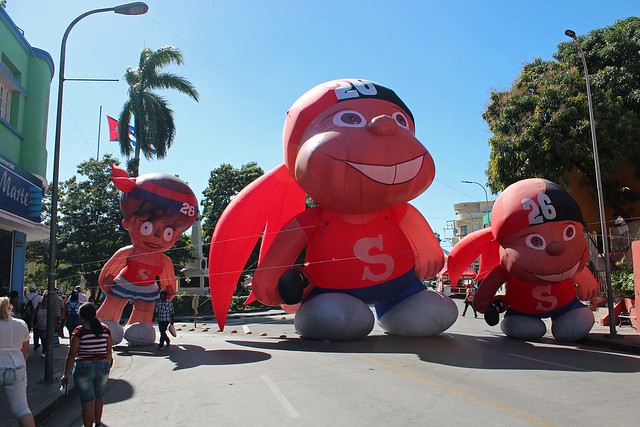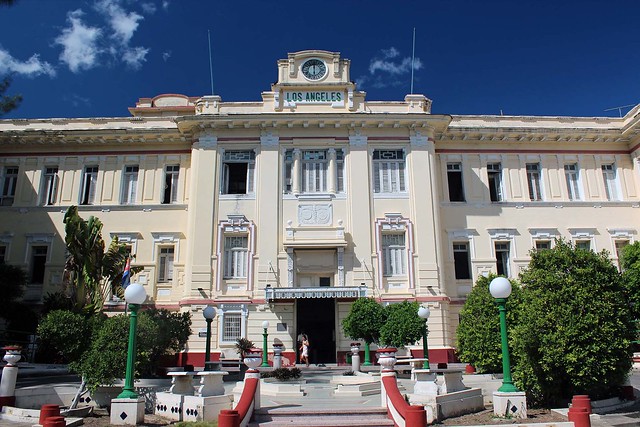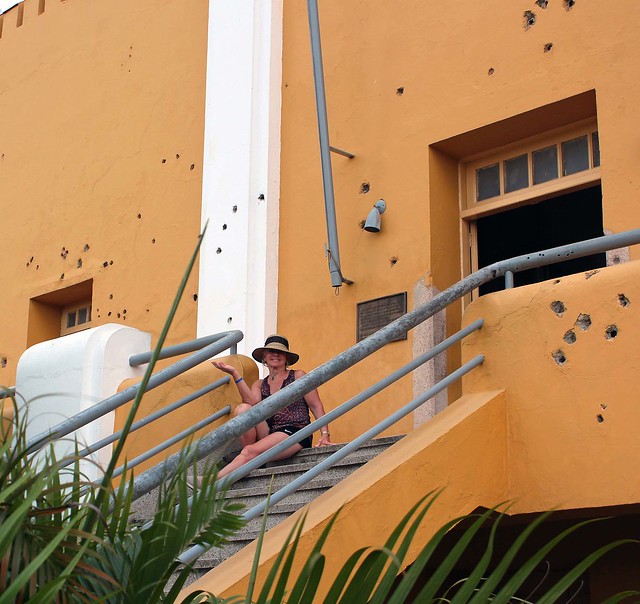More photos from this trip: https://www.flickr.com/photos/jack_1962/albums/72157715781556618
Blog in Polish/blog w języku polskim: http://ontario-nature-polish.blogspot.com/2020/08/pywanie-na-kanu-po-rzece-french-river-w.html
 |
| GPS Tracks of our trip and our day trip around Boom Island |
In 1995 I discovered this beautiful region of Ontario and since then I have frequently been coming back to canoe, camp, fish and just enjoy its extraordinary scenery and serenity.
My
last trip (July, 2018) was not really that pleasant—it was very hot &
humid, fire ban was in effect, hordes of mosquitoes mercilessly attacked us
every evening, and to add insult to injury, we were eventually forced to
immediately evacuate from the park due to the raging forest fire (“Parry Sound
33”) which ultimately destroyed 11 thousands hectares. Obviously, I hoped that
this trip would turn out a little better.
 |
| Our campsite on Boom Island |
Bülent and I departed from Hartley Bay Marina on July 28, 2020. Because of COVID-19, no valet parking was offered. I also found out that Mr. Mike Palmer, the marina’s owner, had passed away in February, 2020 in Hartley Bay.
 |
| Campfire |
After 30 minutes of paddling, we reached Wanapitei Bay and checked out a few vacant campsites on its east shore (#612 & #613). They were OK, but we decided to cross the bay and take a look at other campsites on the opposite shore. The campsites at the ‘intersection’ of Main & Western Channels (#617 & #618) were occupied, campsite #616 was nice, but required a short hike up a steep rocky hill and campsite #611, which I had wanted to camp on in the past, also was occupied. Finally we found a somehow secluded cove/inlet with two campsites and one of them appeared to be very pleasant, with plenty of space for tents, a spot to set up a tarp in case of rain, cool rock formations and four (!) fire pits. The campsite also offered a nice view on the inlet’s rocky shores and islands on Wanapitei Bay with two vacant cottages (since 70% of all cottages on the French River are owned by Americans—who cannot cross the border due to the corona virus—many cottages were unoccupied.). The campsite also made a good fishing spot.
 |
| View from our campsite |
There was a ‘thunderbox’ (a.k.a. a toilet) back in the forest, yet I noticed that not all previous campers had used it—there were pieces of toilet paper scattered all over the campsite. I do not understand why some people are so inconsiderate and not only aren’t they using the latrine, but cannot even pick up after themselves. There was some glass here and there and semi-burned beer cans in the fire pits. By the way, we did not bring any glass containers and religiously collected all the garbage/recyclables, which we took back to Hartley Bay Marina.
 |
| Our food was always secure |
 |
| Typical scenery on the French River |
Our campsite—along with 10 others—was located on Boom Island (approximately 4.5 x 3 km). The island’s west and north shores were surrounded by the Wanapitei River. For some reasons I had never had an opportunity to explore this part of the park, so one day we departed before noon, headed south, turned right into Western Channel and then north just before Attwood Island. Near the mouth of the river we admired a large beaver lodge.
 |
| A very solid beaver lodge at the mouth of the Wanapitei River |
Even though we were paddling against the current, it was hardly noticeable. Around the Forks we caught a pike—several minutes later we found a perfect picnic spot on a rock, cleaned & fried the fish and enjoyed a tasty shore lunch.
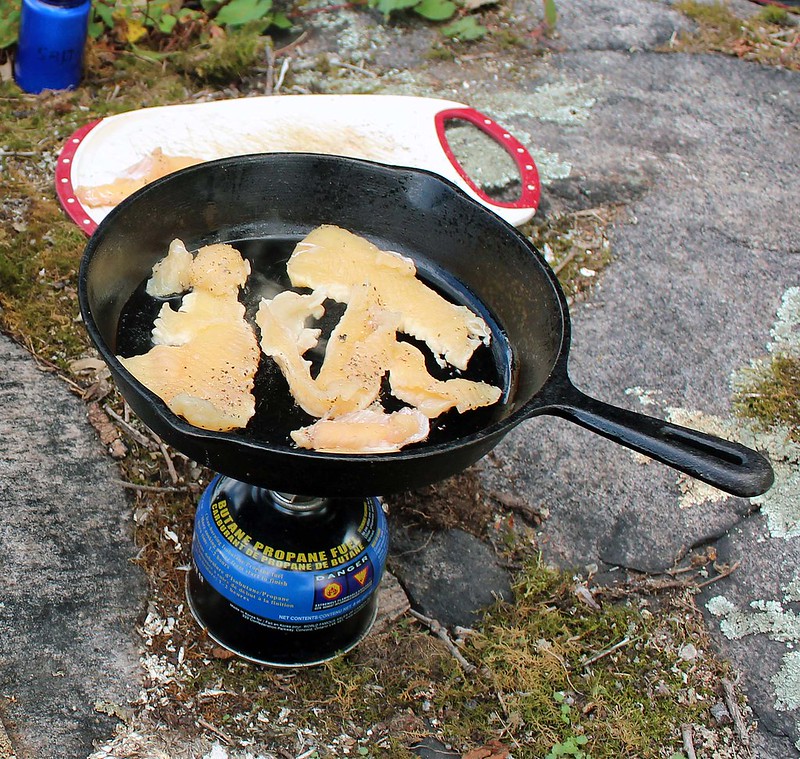 |
| A quick shore lunch; the fresh pike was delicious! |
We proceeded north, until we reached the chutes (Sturgeon Chutes). There were 3 campsites (#604, #605 & #606), but I would not like to stay on them for more than one night—two pontoon boats were docked there and a bunch of people were enjoying their day-trip there as well as several fishermen tried their luck around the chutes. In addition, a 240 m portage was very close to the campsites.
 |
| Sturgeon Chutes |
After taking several photos and paddling as close to the chutes as possible, we started heading back to the campsite. At the Forks we made a left turn. We passed one campsite on the right (#603) and as we reached Kentucky Club Island, we made a sharp right turn and now headed along the eastern shore of Boom Island, passing several campsites. I stopped in front of campsite #609 and took a few photos: I had camped on this very campsite in 2015 and on a daily basis enjoyed the company of 4 black bears—one of them had eventually caused a lot of damage to some of our supplies. Well, this year we did not see any bears, supposedly the blueberries were plentiful and bears were not interested in devouring campers… I mean, campers’ food! Overall, we covered a distance of 23 km.
 |
| Carrying the canoe over the beaver dam |
Just meters from our campsite was a small lake. Upon a closer examination, I realized it was a beaver pond, separated from the French River by a solid beaver dam. It was too good an opportunity to pass—we carried the canoe over the dam and spent almost 2 hours paddling on this enchanted pond!
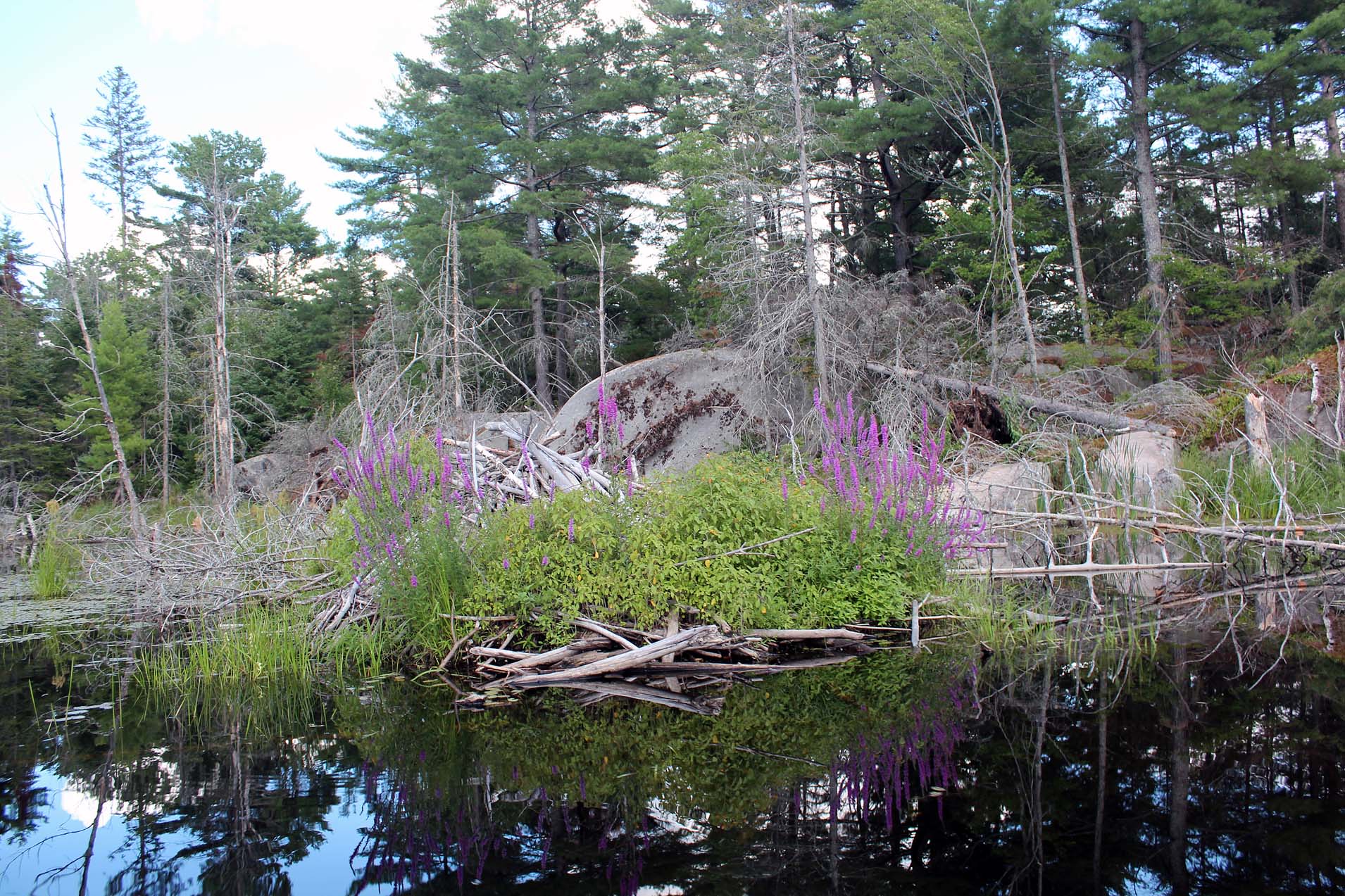 |
| Canoeing on the beaver pond |
There were several beaver lodges, plenty of dead trees and stumps sticking out form the water which was mostly covered by water lily leaves and flowers. At one point we saw a magnificent Blue Heron—it splendidly flew off and gracefully landed nearby on a tree’s branch. We did not see any beavers, but at night we heard splashing sounds coming from the beaver pond as well as mysterious thuds, resembling a woodpecker pecking at trees.
 |
| Canoeing on the beaver pond |
One day we went on a hike in the bush behind the campsite, navigating among fallen, dead and rotting trees, thick undergrowth and many rocks. We had to watch each step and overall covered just 2 km in as many hours. Considering that literally all the trees had been logged in the area some 150 years ago and the current forest was relatively pretty young, I could only imagine how difficult—well, basically impossible—it was to traverse in the forest before that time! That was why rivers, especially the French River, were the only possible routes to explore the new country with a relative ease. During our short sally we did not spot any animals save for a small garter snake. We saw plenty of deer (or moose) droppings, but no bears’. Blueberry bushes were abundant, but I guess the blueberry season was almost over—besides, it was very dry and whatever berries we did find were tiny.
 |
| Our campsite on Boom Island |
The only animals we saw on or around the campsite were ubiquitous sea gulls, green frogs, a chipmunk, a busy squirrel, a large garter snake that I found in my tent’s vestibule and a bunch of snapping turtles, emerging from the water and hoping to get some of our food. As we were paddling towards campsite #616, we saw a family of minks frolicking on the rocky shore. But we were in for a special treat the last day, while heading back to Hartley Bay Marina—we saw a Bald Eagle flying just above our canoe, its distinct white head clearly visible.
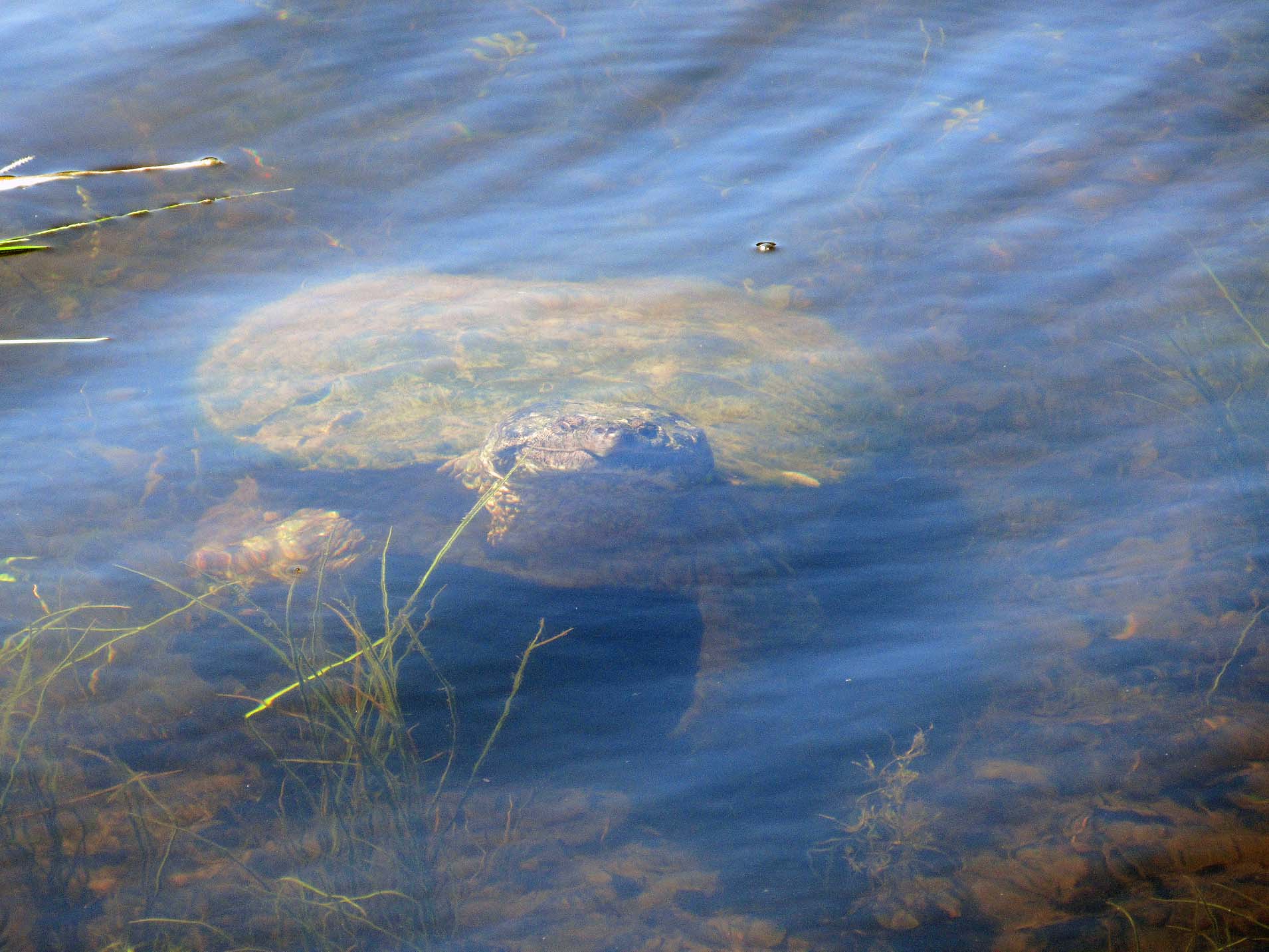 |
| No doubt, a curious and hungry snapping turtle at our campsite |
Since it was very warm, yet not too humid, we liked the weather—at least there was no fire ban. It rained on a couple of occasions, including the whole Sunday. We spent most of that rainy day sitting under the tarp, drinking hot tea and reading books—I managed to finish John Grisham’s “The Rooster Bar”, which was a perfect camping book—light, but not too dumb.
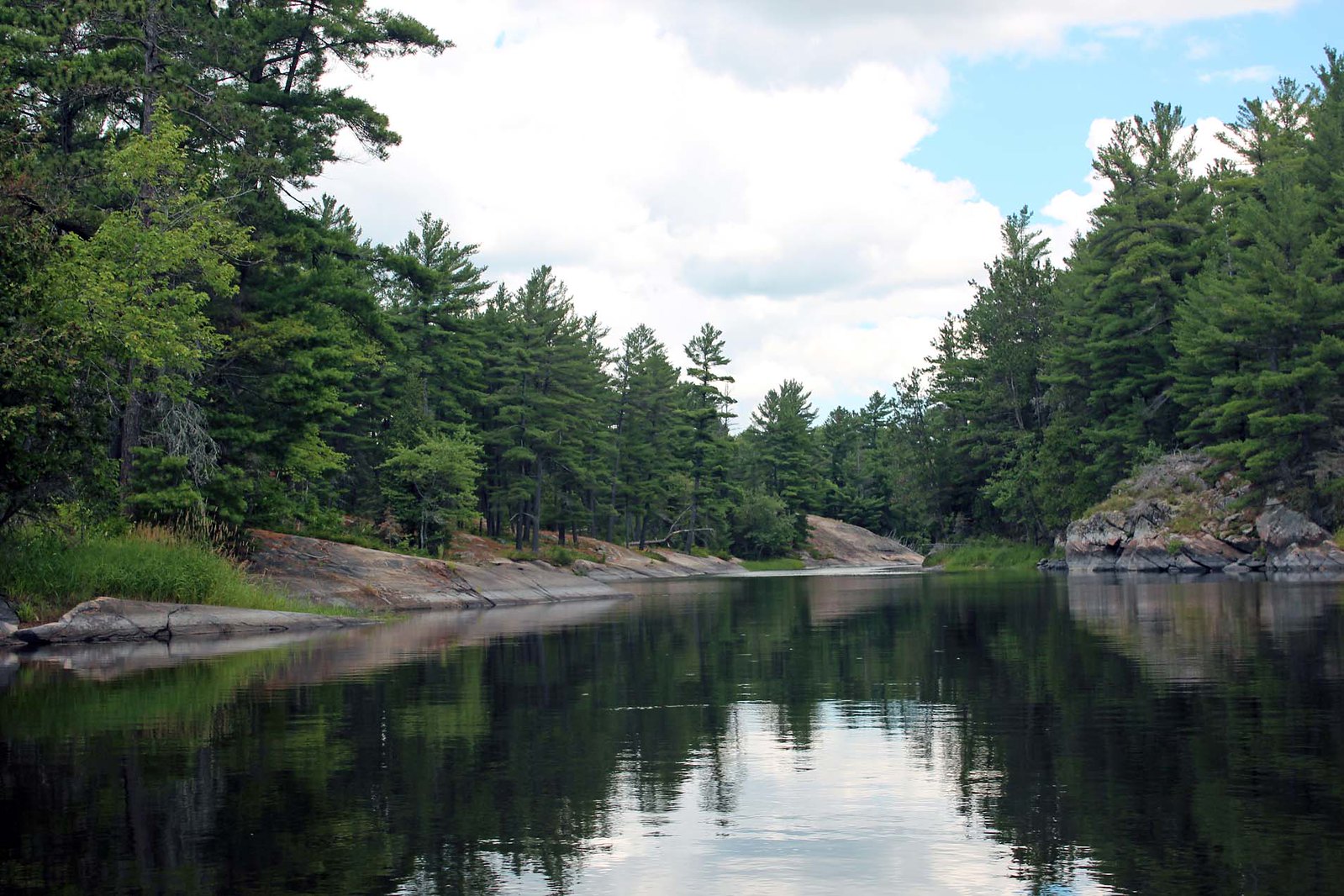 |
| Wanapitei River |
Miraculously, there were VERY FEW mosquitoes! They became active at about 9:15 pm and were mostly gone at 10 pm. One evening, when it became cooler than usual, we did not even have to apply any bug spray, as there were hardly any mosquitos. Upon coming come, I discovered one black fly bite—although the black fly season ‘officially’ should be over at the beginning of July, it’s still possible to encounter black flies in August and September.
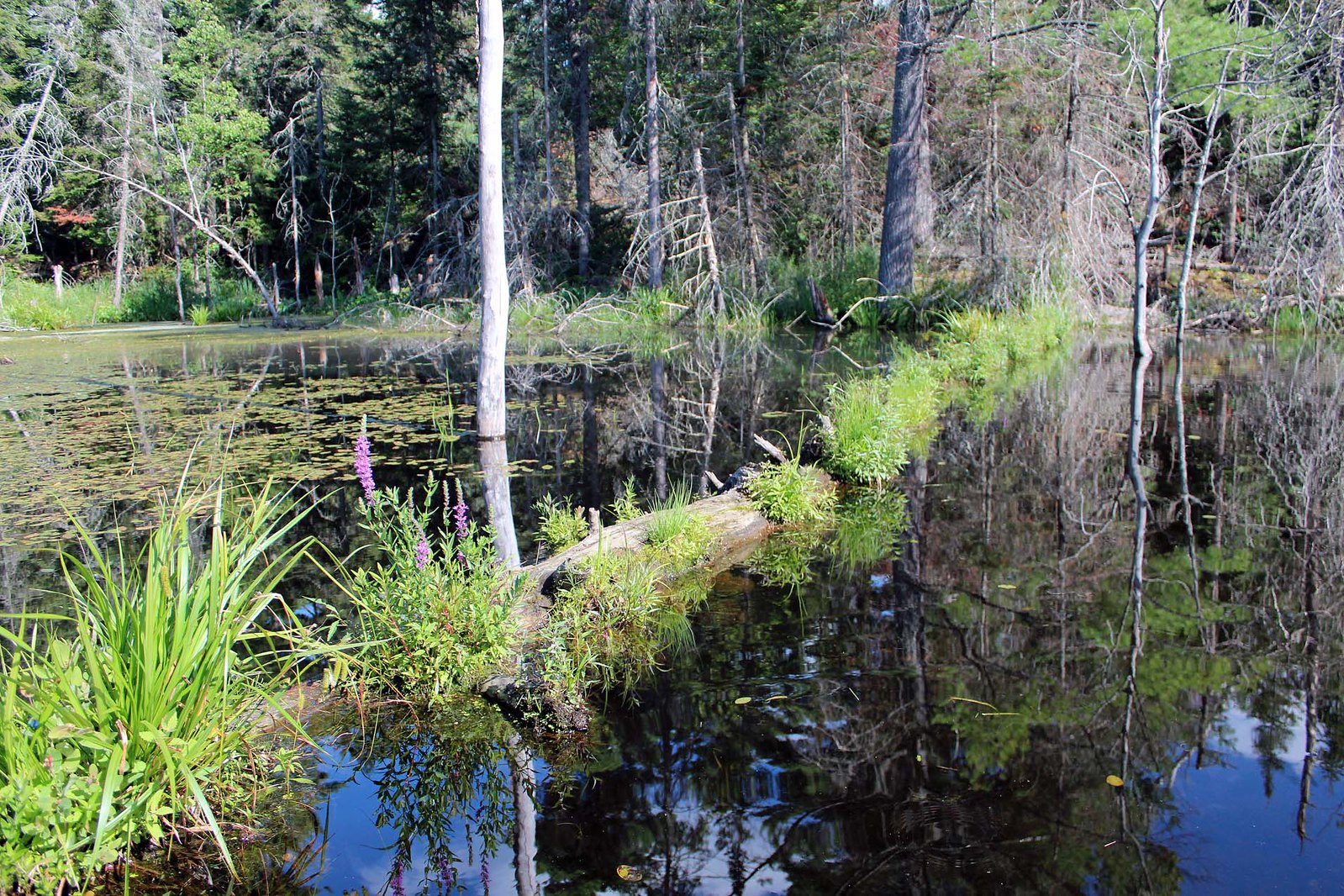 |
| Canoeing on the beaver pond |
 |
| We spent one night in Grundy Lake Provincial Park on campsite number 419 |
After canoeing & camping on the French River for one week, we decided to spend our last night in this park. Because of COVID-19 most Ontario parks were almost 100% booked over weekends, but since it was Monday, there were still some campsites available, at least for one night.
 |
| View from our campsite |
The staff at the office was very efficient and quickly found a site for us, as well as we bought a bag of wood. We got campsite #419 in the Red Maple campground (radio and pet free) which was not bad, adjacent to Grundy Lake and the beach. There were some people canoeing and fishing on the lake. The bathrooms were clean, but there were no showers due to the corona virus situation. Unfortunately, there was a noticeable whiff apparently coming from the toilet, located behind another campsite. We were told there were no black bears sightings in the park this year. Our campsite was also a home to a number of rather friendly chipmunks, which were constantly looking for food and often chased one another. Amazingly, we were hardly bothered by mosquitoes in the evening. There were many families with children and perhaps because of that, around 10 p.m. the park became very quiet as most campers went to sleep—and soon we followed, too.
Just in front of the park’s entrance is Grundy Lake Supply Post, offering canoe rentals, ice cream and plenty of various camping supplies and souvenirs. Also, there is an LCBO store and grocery/butcher store (“Lemieux Meat and Grocery”) in the town of Alban, about 20 km north from the park. Last, but not least—my canoe, purchased at the Grundy Lake Supply Post in 2010, just turned 10 years old and it has been one of the best investments I have ever made!
 |
| If you are adventurous, from Parry Sound you can take a scenic flight over Georgian Bay. I did in the late 1990s and it was awesome! |
Later I found out that just a couple of days before our arrival, a horrible accident had taken place in the park: a 2 year old girl accidentally fell into a campfire and sustained severe burns. Eventually a chopper landed in the park’s parking lot and transported her, I presume, to the Sick Children’s Hospital in Toronto.
 |
| Parry Sound |
On our way back we stopped in Parry Sound, had coffee under the train trestle and as we finished, we saw the Island Queen Cruise depart at 1:00 pm for the sightseeing tour. At that very moment we heard the news about the horrible explosion in Beirut which destroyed part of this city. Then we walked along the docks, observed a floatplane take off and land as well as took a look at the Charles W. Stockey Centre, which was unfortunately closed.
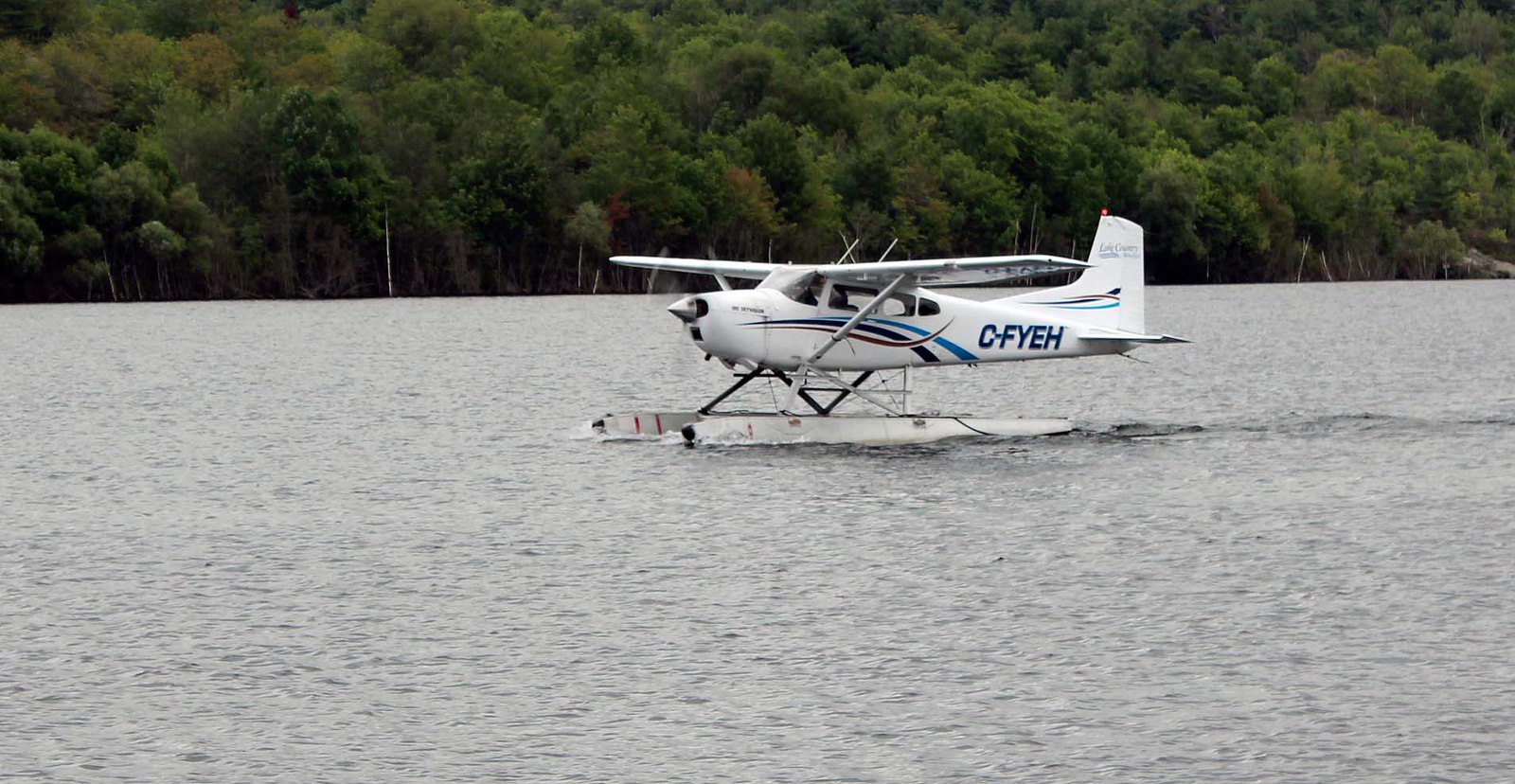 |
| Float planes are quite a common sight in Ontario |
A visit to Parry Sound is never complete without visiting the “Bearly Used Book” store (in my opinion it is the best used book store between Toronto, Vancouver, Alaska and Ellesmere Island)! I was completely enthralled with both the quantity and quality of the books. In my favorite section I quickly browsed through so many unique non-fiction books on history, wars, China, espionage, foreign politics, communism, travel… In no time I purchased 6 really fascinating books and had to discipline myself to leave the store within one hour—after all, I had to drive to Toronto. I had an opportunity to chat with the bookstore’s owner and congratulated her on this amazing undertaking. I was glad to hear that the bookstore was doing well and I was told that soon its size would significantly increase.
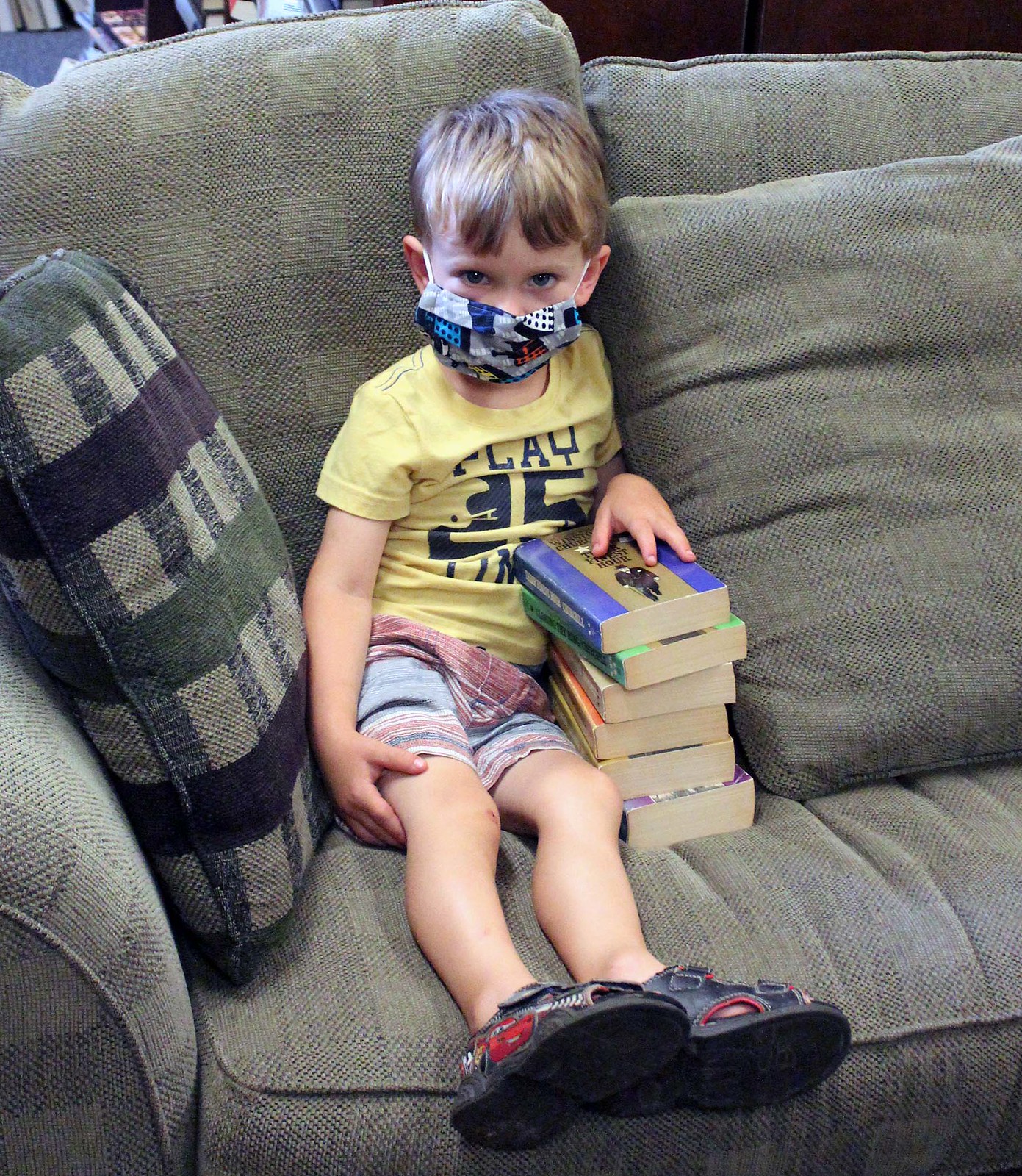 |
| Bearly Used Books store. No wonder he is so tired, he had just finished reading all these books! |
It was a very relaxing trip. For me, French River Provincial Park has always been and will remain a very unique place. I would love to visit this area soon!
More photos from this trip: https://www.flickr.com/photos/jack_1962/albums/72157715781556618
Blog in Polish/blog w języku polskim: http://ontario-nature-polish.blogspot.com/2020/08/pywanie-na-kanu-po-rzece-french-river-w.html







